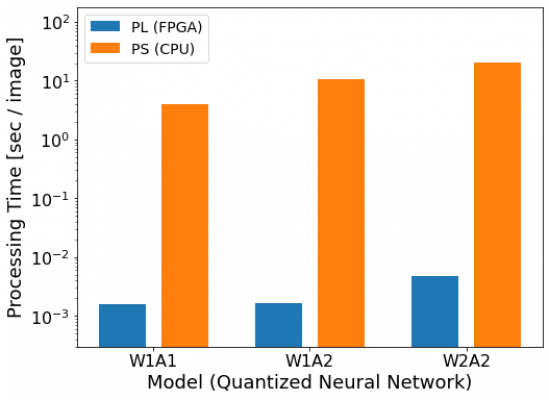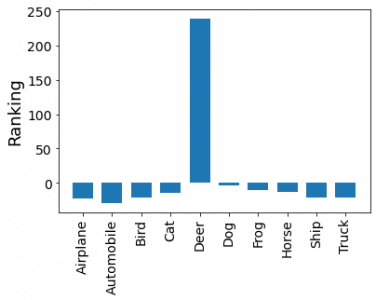BNN-PYNQ
Getting Started
Publications
See FINN for the publications
Model Structures
https://www.hackster.io/adam-taylor/training-implementing-a-bnn-using-pynq-1210b9
- LFC: 4 fully connected network for 28 x 28 x binary (black/white) input
- CNV: 6 convolution + 2 max pooling + 3 fully connected network for 32 x 32 x 3×8-bits (RGB) input
- The output activation is determined by the sign function: {+1 if x >= 0, -1 if x < 0}
Board Setup
See PYNQ-Z1 for the installation
Installation on Target Board
https://github.com/Xilinx/BNN-PYNQ
sudo apt-get update sudo apt-get upgrade
#sudo pip3 install git+https://github.com/Xilinx/BNN-PYNQ.git sudo pip3 install git+https://github.com/Xilinx/BNN-PYNQ.git --no-build-isolation
Sample Execution on Target Board (CNV-QNN_CIFAR10)
## Run bnn/CNV-QNN_Cifar10.ipynb on Jupyter Notebook
Sample Image

Processing Time: PL-FPGA (100 MHz) vs PS-CPU (650 MHz)

Class Rankings: CNVW1A1/CNVW1A2/CNVW2A2



Training on Host Machine (CNV-QNN_CIFAR10)
Tips
- Training could be not on the FPGA board but on AWS/GCP with GPU
- Install CUDA 10.2 + cuDNN 7.6.5 on Ubuntu 18.04 for faster training with Nvidia GPU
- Latest CUDA is incompatible with training scripts
- Install Anaconda for easy installation
- CPU Runtime: 1000 sec/epoch $\times$ 500 epoch = 140 hours
- GPU Runtime: 30 sec/epoch $\times$ 500 epoch = 4 hours (Tesla T4)
- Python 2.7 is necessary
- Original steps are not functional with the latest libraries in 2023
Install (Original/Failed)
https://github.com/Xilinx/BNN-PYNQ/tree/master/bnn/src/training
## Dependencies sudo apt-get install -y git python-dev libopenblas-dev liblapack-dev gfortran sudo apt-get install g++
## Pip #wget https://bootstrap.pypa.io/get-pip.py && python get-pip.py --user wget https://bootstrap.pypa.io/pip/2.7/get-pip.py && python get-pip.py --user
## PATH
export PATH="$HOME/.local/bin${PATH:+:${PATH}}"
## Theano/Lasagne pip uninstall pyyaml pip install pyyaml pip install --user pathlib pip install --user git+https://github.com/Theano/Theano.git@rel-0.9.0beta1 pip install --user https://github.com/Lasagne/Lasagne/archive/master.zip
cat << EOF > ~/.theanorc [global] floatX = float32 device = gpu openmp = True openmp_elemwise_minsize = 200000 [nvcc] fastmath = True [blas] ldflags = -lopenblas [warn] round = False EOF
## PyLearn2 pip install --user numpy==1.11.0 git clone https://github.com/lisa-lab/pylearn2 cd pylearn2 python setup.py develop --user cd
## Data Download export PYLEARN2_DATA_PATH=~/.pylearn2 mkdir -p ~/.pylearn2 cd pylearn2/pylearn2/scripts/datasets python download_mnist.py ./download_cifar10.sh cd
Theano shows some errors here with the latest CUDA 11.8 + cuDNN 8.9.1
The following section is a workaround solution in 2023
Install (Successful)
https://qiita.com/harmegiddo/items/6d7490214b693150cef9
## Anaconda conda create --name pynq python=2.7 conda activate pynq conda install tensorflow=2.1.0=gpu_py27h9cdf9a9_0 conda install pygpu
pip install cython pip install keras==2.3.1 pip install theano==1.0.5 pip install https://github.com/Lasagne/Lasagne/archive/master.zip
cat << EOF > ~/.theanorc [global] floatX = float32 device = cuda openmp = True openmp_elemwise_minsize = 200000 [nvcc] fastmath = True [blas] ldflags = -lopenblas [warn] round = False EOF
Training
git clone https://github.com/Xilinx/BNN-PYNQ.git export XILINX_BNN_ROOT="$HOME/BNN-PYNQ/bnn/src/"
cd ./BNN-PYNQ/bnn/src/training/
The original cifar10.py is modified to avoid using pylearn2 and to use keras for downloading data:
bnn-pynq_cifar10_mod.py.gz
python cifar10_mod.py #python cifar10_mod.py -wb 1 -ab 2 #python cifar10_mod.py -wb 2 -ab 2
Using cuDNN version 7605 on context None Mapped name None to device cuda: Tesla T4 (0000:00:04.0) Using TensorFlow backend. activation_bits = 1 weight_bits = 1 batch_size = 50 alpha = 0.1 epsilon = 0.0001 W_LR_scale = Glorot num_epochs = 500 LR_start = 0.001 LR_fin = 3e-07 LR_decay = 0.983907435305 save_path = cifar10-1w-1a.npz train_set_size = 45000 shuffle_parts = 1 Loading CIFAR-10 dataset... ... Training... Epoch 1 of 500 took 31.9853491783s LR: 0.001 training loss: 0.715714348786407 validation loss: 0.3401033526659012 validation error rate: 57.180000364780426% best epoch: 1 best validation error rate: 57.180000364780426% test loss: 0.33863225907087324 test error rate: 56.81000013649463%
Weight
python cifar10-gen-weights-W1A1.py #python cifar10-gen-weights-W1A2.py #python cifar10-gen-weights-W2A2.py
ls cnvW1A1
0-0-thres.bin 0-9-thres.bin 1-21-thres.bin 1-7-thres.bin 2-6-thres.bin 3-5-thres.bin 0-0-weights.bin 0-9-weights.bin 1-21-weights.bin 1-7-weights.bin 2-6-weights.bin 3-5-weights.bin 0-1-thres.bin 1-0-thres.bin 1-22-thres.bin 1-8-thres.bin 2-7-thres.bin 3-6-thres.bin 0-1-weights.bin 1-0-weights.bin 1-22-weights.bin 1-8-weights.bin 2-7-weights.bin 3-6-weights.bin ... 0-6-thres.bin 1-19-thres.bin 1-4-thres.bin 2-3-thres.bin 3-2-thres.bin 8-0-weights.bin 0-6-weights.bin 1-19-weights.bin 1-4-weights.bin 2-3-weights.bin 3-2-weights.bin 8-1-weights.bin 0-7-thres.bin 1-2-thres.bin 1-5-thres.bin 2-4-thres.bin 3-3-thres.bin 8-2-weights.bin 0-7-weights.bin 1-2-weights.bin 1-5-weights.bin 2-4-weights.bin 3-3-weights.bin 8-3-weights.bin 0-8-thres.bin 1-20-thres.bin 1-6-thres.bin 2-5-thres.bin 3-4-thres.bin classes.txt 0-8-weights.bin 1-20-weights.bin 1-6-weights.bin 2-5-weights.bin 3-4-weights.bin hw
Run on Target Board (PYNQ-Z1)
## Copy weight files to /usr/local/lib/python3.6/dist-packages/bnn/params/original/cnvW1A1 on PYNQ cd /usr/local/lib/python3.6/dist-packages/bnn/params/ mkdir -p original/cnvW1A1
## Run bnn/CNV-QNN_Cifar10.ipynb on Jupyter Notebook
Training on Host Machine (LFC-BNN_MNIST)
Tips
- CPU Runtime: 100 sec/epoch $\times$ 1000 epoch = 30 hours
- GPU Runtime: 2 sec/epoch $\times$ 1000 epoch = 0.5 hours (Tesla T4)
Training
The original mnist.py is modified to avoid using pylearn2 and to use keras for downloading data:
bnn-pynq_mnist_mod.py.gz
python mnist_mod.py #python mnist_mod.py -wb 1 -ab 2
Using cuDNN version 7605 on context None Mapped name None to device cuda: Tesla T4 (0000:00:04.0) Using TensorFlow backend. activation_bits = 1 weight_bits = 1 batch_size = 100 alpha = 0.1 epsilon = 0.0001 num_epochs = 1000 dropout_in = 0.2 dropout_hidden = 0.5 W_LR_scale = Glorot LR_start = 0.003 LR_fin = 3e-07 LR_decay = 0.990831944893 save_path = mnist-1w-1a.npz train_set_size = 50000 shuffle_parts = 1 Loading MNIST dataset... ... Training... Epoch 1 of 1000 took 2.09121918678s LR: 0.003 training loss: 0.26854227716475726 validation loss: 0.044894146784208715 validation error rate: 6.429999990388752% best epoch: 1 best validation error rate: 6.429999990388752% test loss: 0.04777069476665929 test error rate: 6.899999972432852%
Spin-Off Projects
References
https://marsee101.web.fc2.com/pynq.html
https://www.tkat0.dev/study-BNN-PYNQ/
https://qiita.com/harmegiddo/items/6d7490214b693150cef9
https://qiita.com/ykshr/items/6c8cff881a200a781dc3
https://discuss.pynq.io/t/new-pynq-2-7-image-got-modulenotfounderror-no-module-named-pynq-when-install-bnn-pynq/3570/5
https://github.com/Xilinx/BNN-PYNQ/tree/master/bnn/src/training
https://qiita.com/ykshr/items/08147098516a45203761
https://gist.github.com/ykshr/a68403f5b073ba8f117faeb0a14385c1
https://qiita.com/kamotsuru/items/dcd460e04385f2738cd7
Acknowledgments
Daiphys is a professional services company in research and development of leading-edge technologies in science and engineering.
Get started accelerating your business through our deep expertise in R&D with AI, quantum computing, and space development; please get in touch with Daiphys today!
Daiphys Technologies LLC - https://www.daiphys.com/